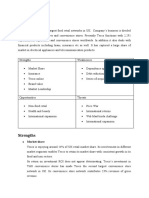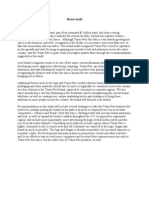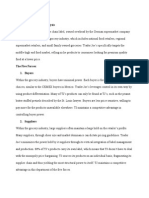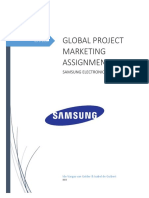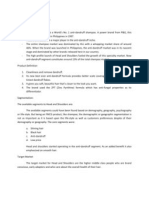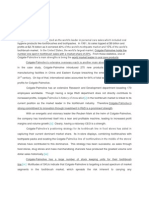Tesco Case Study
Tesco Case Study
Uploaded by
Hassan ZulqernainCopyright:
Available Formats
Tesco Case Study
Tesco Case Study
Uploaded by
Hassan ZulqernainCopyright
Available Formats
Share this document
Did you find this document useful?
Is this content inappropriate?
Copyright:
Available Formats
Tesco Case Study
Tesco Case Study
Uploaded by
Hassan ZulqernainCopyright:
Available Formats
1
Impact of cultural differences in Global marketing and the Issues faced by the Companies: Case Study of Tesco Corporations
Name:
Institutions Name Course Name Date
Impact of cultural differences in Global marketing and the Issues faced by the Companies: Case Study of Tesco Corporation According to Clark (2008), Tesco food retailer supermarkets started operations as a grocery store in 1919 with Jack Cohen being the pioneer of the business. The first location of the small grocery store was London East. From a domestic beginning, the business started making profits and in 1924, the brand got first recognition in the market following a shipment from Mr Stockwell. The first store flagship store started in north London in Burnt Oak. In 1930, a warehouse started operations in north London that was also the headquarters of the Tesco. In 1932, the company registered as a private limited venture. In 1947, the company marked a great milestone as they joined the stock exchange. In the 1950s Tesco acquired other rival such as Harrow shops and the Williams stores. In the 1960s the Tesco was a stable chain of stores selling across UK and in the 1970s they the supermarkets managed to cover the whole of UK. Product line extension also attributed to the changing business. Clark (2008) further states that, the supermarket has been expanding in product line reaching different markets in the world.
In 2006, Tesco started operations in the USA and presently the supermarket is in 13 nations of the world. According to Ron (2005), marketing of businesses across different societies and cultures in the world is becoming a live business and the world is moving to capture the global economy. He further clarifies that, many of the global companies have been able to succeed in different markets regardless of cultural differences. It is important for a business to understand the different cultures that are prevailing in marketing their products and services into global markets. Political, local and business cultures exist in every market and understanding them is crucial in the overall performance of a business. Addressing marketing strategies in relation to business across different markets is crucial in running a business according to (Ron 2005). The response of people towards different marketing messages is different and different things drive peoples choice. Cultural considerations are important and if they lack, mediocre responses to marketing and promotions results. This can affect the image of the companys products in the world. According to Kaikati & Kaikati (2013), culture understanding in every market is crucial as it gives clarity of the market. National cultures see accomplishment in lifestyles as a benchmark for measuring success. People meeting the standards prove different and their regards are highly. As a result, the chances of this group of people accepting advertisements and promotions are high. Conversely, people who base their life achievements on the place of birth and influence prove hard and the results of promotions and marketing are very poor according to (Chatterjee 2013).
In different nationalities, people fear taking risks as compared to others where a positive attitude of success prevails. Some factors like colors and symbols are very crucial in any marketing efforts as they drive the buyers behavior. In some countries, some colors are appealing while they are not acceptable to other people. For instance, red is a color appealing and reflecting luck to the Chinese. On the other side, red color is a signal of danger to other people. This factor can affect marketing through websites, print as well as media ads. Research is necessary in the understanding cultural differences in order to maximize the advertisement and promotional messages on the international market. The aim of this essay is to analyze the impact of cultural differences on multinational companies. Special emphasis focuses on the operation of Tesco supermarkets. Tesco supermarkets have been on the thriving end and for many days, the company is really changing its business roots. Tesco currently have more than 10 countries of operation and they are reaching new markets in the world today. Despite the prevailing challenges and competition, the supermarkets are still recording high profits from their extended product lines suitable to different markets. This created a culture of buying within the UK market and many clients gained access to different pricing of the company. The Tesco group has been facing a lot of criticism in different issues of operation. The company has been gaining popularity over the years and they have ventured into different world markets hence creating a great base for their products. According to Palpacuer & Bair (2012), Tesco experiences criticism due to its monopolistic operation especially in the UK. Small businesses have been in tough competition and they are experiencing slow growth since the supermarket chain has
taken the biggest market share in the country. Small growing companies find it hard to venture into the market due to tight competition from Tesco. Although this has been a threat to the business, the company is still expanding its operation in the world. Another criticism that challenges the Tesco is the mode of acquiring lands. Tesco has aggressive methods and this portrays a bad image to the overall operation of the business. This is slowing the growth and appeal of the business in new faces of the world. Furthermore, pricing of the products is not acceptable in many markets. Most of the prices are luring and they do not reflect the right business focus. This has been a problem to other supermarkets in the world.
You might also like
- Marks and Spencer Case StudyDocument11 pagesMarks and Spencer Case StudyGeorgia RogersNo ratings yet
- The Coop: Market ResearchDocument1 pageThe Coop: Market ResearchAparna0% (1)
- Porter's Five ForcesDocument4 pagesPorter's Five Forcesharini muthuNo ratings yet
- Captură de Ecran Din 2022-01-18 La 18.26.19Document9 pagesCaptură de Ecran Din 2022-01-18 La 18.26.19Liliana MilitaruNo ratings yet
- Conjoint and Segmentation Analysis: The KIRIN Case StudyDocument25 pagesConjoint and Segmentation Analysis: The KIRIN Case StudyRonil JainNo ratings yet
- Millward Brown Optimor Case StudyDocument2 pagesMillward Brown Optimor Case StudySumit RanjanNo ratings yet
- Starbucks Case Write UpDocument2 pagesStarbucks Case Write UpJess RazzNo ratings yet
- Strengths: Swot AnalysisDocument4 pagesStrengths: Swot Analysisawan11No ratings yet
- Brand Audit BrandingDocument8 pagesBrand Audit Brandingcasey_d_roweNo ratings yet
- Herborist CaseDocument7 pagesHerborist CaseRanjani Cool Ranjani0% (1)
- Integrative Case 14Document3 pagesIntegrative Case 14Neshvar Dmitri100% (1)
- Swot AnalysisDocument5 pagesSwot AnalysisHariprasad KS100% (1)
- ULMS 270 The Critical Analysis of Tesco's Development and The Opportunity of Furthering International GrowthDocument16 pagesULMS 270 The Critical Analysis of Tesco's Development and The Opportunity of Furthering International GrowthLiv MaloneyNo ratings yet
- Guidelines For Preparation of TIVO in 2002Document2 pagesGuidelines For Preparation of TIVO in 2002MOUSOM DATTANo ratings yet
- Case Application - TescoDocument4 pagesCase Application - TescoDianna Grace SoNo ratings yet
- Body ShopDocument6 pagesBody Shopannush17No ratings yet
- Bosch India'S Starter Motor and Generator Division: Pioneering A Network Form of OrganizationDocument10 pagesBosch India'S Starter Motor and Generator Division: Pioneering A Network Form of OrganizationRaahim NajmiNo ratings yet
- EFAS WalmartDocument1 pageEFAS WalmartNida ShahzadNo ratings yet
- Course Meeting Date/Time: 09/16/2019 / 11:00AM Case: Carolina Foods, Inc. Name: Karla Moreno Date: 09/14/2019Document3 pagesCourse Meeting Date/Time: 09/16/2019 / 11:00AM Case: Carolina Foods, Inc. Name: Karla Moreno Date: 09/14/2019KarlaNo ratings yet
- 01 TESCO CRM+Champion - UnlockedDocument17 pages01 TESCO CRM+Champion - Unlockedappiwadhwa44No ratings yet
- Smells Like Teen SpiritDocument17 pagesSmells Like Teen SpiritManu MantillaNo ratings yet
- Vera Bradley in 2014Document9 pagesVera Bradley in 2014Adrian BenczeNo ratings yet
- Trader Joes AnalysisDocument2 pagesTrader Joes AnalysisywriterctNo ratings yet
- Schiffman14 ImDocument17 pagesSchiffman14 ImManisha Dimri BachhetiNo ratings yet
- Gillette Mach 3 - Brand ElementsDocument23 pagesGillette Mach 3 - Brand Elementsmanish_mittalNo ratings yet
- Group Assignment SM.Document6 pagesGroup Assignment SM.Waheed LangahNo ratings yet
- Sainsbury'sDocument6 pagesSainsbury'scebucpatriciaNo ratings yet
- Apple Harvesting in IndiaDocument38 pagesApple Harvesting in Indiaphani_mtpNo ratings yet
- Final Assignment RevDocument23 pagesFinal Assignment RevAndrew Cokro PutraNo ratings yet
- Stratman-Pepsico-Group 3 1603Document42 pagesStratman-Pepsico-Group 3 1603Ponco PrayogoNo ratings yet
- Assignment 1Document26 pagesAssignment 1Mohammed TambawalaNo ratings yet
- House of TataDocument36 pagesHouse of TataHarsh Bhardwaj0% (1)
- Arnett Tijah OAM335-1172 Short Response-4Document2 pagesArnett Tijah OAM335-1172 Short Response-4Tijah ArnettNo ratings yet
- Quản trị MAR TADocument153 pagesQuản trị MAR TANguyen Ngoc Phuong Anh100% (1)
- CritiqueDocument1 pageCritiqueSamarth Bharadwaj ➘No ratings yet
- Welcome To Our Presentation: Your Date HereDocument16 pagesWelcome To Our Presentation: Your Date HereMD ShahriarNo ratings yet
- Energy Bars Case Analysis 2 - Group 5Document6 pagesEnergy Bars Case Analysis 2 - Group 5Ritika SharmaNo ratings yet
- IBS AssignmentDocument4 pagesIBS AssignmentAnand KVNo ratings yet
- China and Its Challenging Market: Giulia Marchini-MIEXDocument10 pagesChina and Its Challenging Market: Giulia Marchini-MIEXWalker SkyNo ratings yet
- Global Project Marketing Assignment 2: Samsung ElectronicsDocument11 pagesGlobal Project Marketing Assignment 2: Samsung ElectronicslovemynaturecountryNo ratings yet
- Ross CorpFin Casemap1Document44 pagesRoss CorpFin Casemap1alokkuma05No ratings yet
- Ua Business StrategyDocument23 pagesUa Business Strategyrakshika somrajanNo ratings yet
- John Lewis - NajmaDocument14 pagesJohn Lewis - Najmawasi ul islamNo ratings yet
- Consumer Behavior FinalDocument23 pagesConsumer Behavior FinalHarsh Sharma100% (1)
- CH 1Document26 pagesCH 1Rameen ZafarNo ratings yet
- Heinz Ketchup: Pricing The Product Line: Rev. Jun. 27, 2011Document13 pagesHeinz Ketchup: Pricing The Product Line: Rev. Jun. 27, 2011Sourav Kumar JenaNo ratings yet
- Head and Shoulders ShampooDocument4 pagesHead and Shoulders Shampooem_manuelNo ratings yet
- Markstrat Report - Company I - Nigel Quah - Yuanxin Gao - Zille HussnainDocument7 pagesMarkstrat Report - Company I - Nigel Quah - Yuanxin Gao - Zille HussnainZillay Hussnain BasijiNo ratings yet
- A Practical Guide To Conjoint Analysis M-0675Document9 pagesA Practical Guide To Conjoint Analysis M-0675Sriram ChepuriNo ratings yet
- VRIO Analysis of ITC Personal Care SectorDocument3 pagesVRIO Analysis of ITC Personal Care SectorMihir Singh Tiwari100% (1)
- BRM Group Assignment Dettol Group7Document3 pagesBRM Group Assignment Dettol Group7Darpan MahajanNo ratings yet
- Running Head: Tivo: Snapple 2018: Healthy Juice ReimaginedDocument8 pagesRunning Head: Tivo: Snapple 2018: Healthy Juice ReimaginedAnggun Citra BerlianNo ratings yet
- COLgate PalmoliveDocument25 pagesCOLgate PalmoliveRavi Kumar Mahato100% (2)
- Final Paper - Trader Joes Marketing CampaignDocument14 pagesFinal Paper - Trader Joes Marketing Campaignapi-663750031No ratings yet
- Natureview Farm SolutionsDocument5 pagesNatureview Farm SolutionsRamona ElenaNo ratings yet
- Managing Britannia: Culture and Management in Modern BritainFrom EverandManaging Britannia: Culture and Management in Modern BritainRating: 4 out of 5 stars4/5 (1)
- Calculate Customer Lifetime Value A Clear and Concise ReferenceFrom EverandCalculate Customer Lifetime Value A Clear and Concise ReferenceNo ratings yet
- International Business Strategy A Complete Guide - 2020 EditionFrom EverandInternational Business Strategy A Complete Guide - 2020 EditionNo ratings yet
- Impact of Social Media On Businesses in USADocument24 pagesImpact of Social Media On Businesses in USAHassan ZulqernainNo ratings yet
- Tesco Case StudyDocument4 pagesTesco Case StudyHassan ZulqernainNo ratings yet
- Tesco Case StudyDocument4 pagesTesco Case StudyHassan ZulqernainNo ratings yet
- Tesco Case StudyDocument5 pagesTesco Case StudyHassan ZulqernainNo ratings yet







